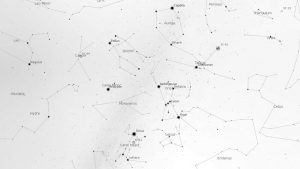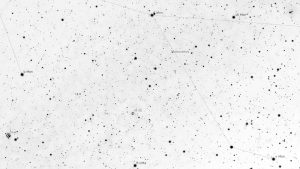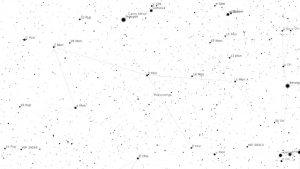| Meaning: | The Unicorn | Print out the star map from Sky and Telescope
Things to look for: Plaskett’s Star Hubble’s Variable Nebula Christmas Tree Cluster NGC 2264 Messier objects: Note: [x.x] indicates visual magnitude |
|
| Pronunciation: | mon oss’ sir us | ||
| Associated Asterisms: | None | ||
| % of the sky: | 1.67 | ||
| Visible Stars: | 36 stars brighter than magnitude 5.5 |


Sitting quietly to the East of Orion is Monoceros, the Unicorn. It first appeared in 1613 on the globe designed by Dutchman Petrus Plancius. It is bordered by Canis Major, Canis Minor, Gemini, Hydra, Lepus, Orion and Puppis. It also straddles the equatorial equator and is. like Orion, associated with the Winter. One of the must sees in this constellation is NGC2244, the Rosette Nebula and is arguably one of the prettiest nebula to be seen. The nebula is complex and is located around the an open cluster of stars; the complexity lead to multiple designations in the NGC for its brightest parts NGC2237, NGC2238 and NGC 2239. Another object, mag 9 NGC 2261 or Hubble’s Variable Nebula is an oddity as the nebula is illuminated by variable star R Monocerotis but the change in brightness of the nebula doesn’t follow the brightness of R Mon. It is thought dust in the nebula periodically obscures the star leading to unexpected dips in intensity.
Plaskett’s star or V640 Monocerotis is an extremely heavy binary system about the mass of 100 Suns. It is resolved spectroscopically and the combined magnitude of the object varies between 6.0 and 6.1 on an irregular basis. John Stanley Plaskett, with the assistance of his son, discovered the oddities of the star in 1922. It was once thought to be a rarity but analysis of other massive stars seems to show some are also binary systems and so rivaling Plaskett’s star.


Given it’s proximity to Orion, the guidance for finding it couldn’t be simpler; just go slightly East. The head of the Unicorn is contained within the three bright stars Sirius, Betelgeuse and Procyon.

The constellation contains a fair smattering of NGC objects well worth a look at. The Rosette Nebula is the main one but others such as the Christmas Tree Cluster and Cone Nebula are work a view.
Hubble’s Variable Nebula was actually discovered by William Herschel in 1783 and is both an emission and reflection nebula.
Guide charts for Messier Objects


